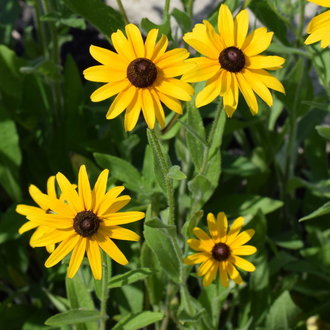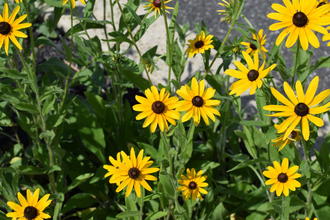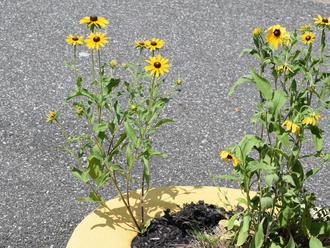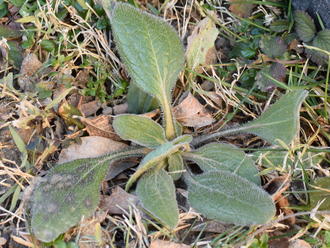Black-eyed Susan (Rudbeckia hirta L.)
↑Summary
An annual, biennial, or short-lived perennial. One of several species bearing the name Black-eyed Susan. Native to a wide range across North America, mostly in the Eastern half of the continent.
↑Range - Expand
| Legend | Color |
| Native | |
| Introduced | |
| Native or Not Present | |
| Introduced or Not Present | |
| Native or Introduced | |
| Native or Expanded | |
| Native or Introduced or Not Present |
This tentative map is based on our own research. It may have limited data on Canada and/or Mexico, and there is some subjectivity in our assignment of plants as introduced vs. expanded. Read more in this blog post.
Although this plant occurs somewhere in each of these regions, it may only occur in a small part of some or all of them.
↑Description & Identification
To 1m (3.2') tall, usually shorter. Branches occasionally, usually near the base, with each stem.
Very similar in appearance to Rudbeckia fulgida; identification is compounded by different varieties and wide variation in both species. R. hirta is usually more consistently hairy, with stiff hairs, usually has lighter-green foliage, and prefers sunnier, drier conditions. R. fulgida is rhizomatous, whereas R. hirta is not.
↑Habitat
In natural habitats, found in prairies, savannas, rocky openings in forests, and areas subjected to recent disturbance. Frequent in anthropogenic habitats, including roadsides and along railroads, in abandoned fields, and on waste ground.
Requires high light conditions, with ample sunlight reaching the ground, and tolerates a wide range of moisture and soil conditions.
↑Life Cycle
Rudbeckia hirta is an opportunistic plant, altering its life cycle considerably in response to different conditions. Many sources list it as a "biennial or annual" but it does not reliably follow a predictable lifecycle the way some biennials do. It can bloom in the first year, often dying after a single season, but it can also persist for more than two years. As a perennial, it is usually short-lived. Survival of plants after blooming is influenced by heat and moisture.
Seeds require considerable direct sunlight and exposed conditions to germinate; this plant often thrives in disturbed areas, such as after fire or mowing. Able to survive repeated mowing or cutting to the ground, but not usually able to flower or set seed in regularly-mowed lawns. Often favored by mowing regimes with long periods, especially if spaced so as to allow flowering and setting of seed.
Bloom time is highly variable, with most blooms from early to mid summer, but many plants continuing to bloom into fall. Some plants adopt the risky strategy of blooming as temperatures fall when the risk of hard frost approaches and pollinators are more scarce.
Basal rosettes of first-year plants or older plants that have persisted after blooming are often evergreen, especially in milder winters.
↑Faunal Associations
The flowers attract a wide range of pollinators, mostly smaller ones, including small bees, flies, and some wasps, beetles, butterflies, and skippers. Aphids also frequently feed on the plant.
Mammals usually avoid browsing on the leaves because their dense, coarse hairs can be irritating. The seeds are occasionally eaten by goldfinches, but are not a preferred food source due to their smaller size.
↑Uses
R. hirta seeds are frequently included in wildflower mixes because of its ease of germination, attractive blooms, and tendency to thrive in disturbed areas.
Sometimes cultivated in gardens, although less frequently than R. fulgida. Some cultivars exist, including ones with orange or red patterns towards the center of rays.
↑Related Plants
There are numerous Rudbeckia species native to North America, many of which overlap in range with R. hirta. Of these, R. fulgida, R. triloba, and R. laciniata have the widest range and are the most abundant in most areas.
R. hirta is very similar visually. R. triloba is somewhat similar but usually easily distinguished by its lobed leaves and smaller flowers. R. laciniata looks very distinct.
R. subtomentosa, locally common from Illinois and Missouri south to Louisiana, also has a similar flower, but grows much taller.
This 2000 phylogenetic analysis placed R. triloba and R. fulgida, as one might expect, as the closest-related to R. hirta of the common species. It also placed the Dracopsis genus in the same clade as Rudbeckia. After these, Ratibida was the next most closely-related genus. There is some uncertainty as to the relationships of other species, but other closely-related genera include Acmella, Ambrosia (Ragweeds), Echinacea (Purple coneflower), Helianthus (Sunflowers), Heliopsis ("False" sunflowers), Philactis, Salmea, Sanvitalia, Trichocoryne, and Zinnia. Most of these plants have showy flowers and are easily recognized as close relatives, but Ambrosia has wind-pollinated flowers and looks quite distinct.
↑Links & External Resources
• Blackeyed Susan | Fire Effects Information System (FEIS) (About This Site)
• Rudbeckia hirta (Black-eyed Susan) | Illinois Wildflowers (About This Site)
• Rudbeckia hirta (Black-eyed Susan) | USDA PLANTS Database (About This Site)
• Rudbeckia hirta | Go Botany (About This Site)
• Rudbeckia hirta (Black-Eyed Susan) | Missouri Botanical Garden Plant Finder (About This Site)
• Rudbeckia hirta | Biota of North America Project (BONAP) (About This Site)
• Rudbeckia hirta | NatureServe Explorer (About This Site)
• Rudbeckia hirta | Flora of North America (About This Site)
• Rudbeckia hirta | Missouri Plants (About This Site)
• Black-eyed Susan | Maryland Biodiversity Project (About This Site)
• Black-eyed Susan (hirta) | Maryland Biodiversity Project (About This Site)
• Black-eyed Susan (pulcherrima) | Maryland Biodiversity Project (About This Site)
• Rudbeckia hirta (Black-eyed Susan) | Minnesota Wildflowers (About This Site)
• Rudbeckia hirta L. var. pulcherrima Farwell (Black-eyed Susan) | Digital Atlas of the Virginia Flora (About This Site)
• Rudbeckia hirta L. var. hirta (Woodland Black-eyed Susan) | Digital Atlas of the Virginia Flora (About This Site)







